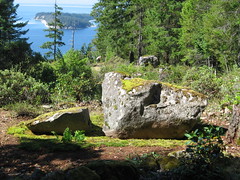Irish Hills Hike
Sunday, February 17th, 2008I found the listing on the ECOSLO bulletin: Irish Hills Docent-Led Hike. A good location to see early flowers, and Jody a congenial leader. As directed, Jan and I drove to the end of Madonna Road and parked in the new subdivision bordering Costco and the Open Space. The houses are large and densely situated on the flat valley floor, stark, typical sprawl bedroom neighborhood, but promising a different atmosphere once the trees have grown enough to provide something of an urban forest. Jan noted that the park with basketball courts and baseball field that can be used by the residents of the projects across the street were required of the developer, Marshall, while she sat on the City Council. So was the preservation of the old farmhouse at the trailhead, which was sold to a private party who could only renovate and expand it in such a way as to preserve the look of the original building.
It was one of those mild spring mornings with a touch of cool brought on by the slight sea mist especially welcome as the group of about ten people mounted the winding trail. The perennial bunch grass was bright green, and several lilies were coming into leaf. The first bloom a white flower I cant identify.
Ascending the serpentine ridge, we gained larger views of the Los Osos Valley, shopping centers and new subdivisions creeping over the fields and hills in every direction.
But a large green patch in the middle of the sprawl remained where the decades-long struggle over the Dalidio property has left the land fertile and fallow. Adjoining it, is the “Gap” property situated along Prefumo Creek between automobile dealerships and the South Laguna residential neighborhood. This was the parcel before the planning commission last Thursday night that Citizens for Planning Responsibly urged be developed in accordance with the General Plan. Jan wrote a long and expert treatise that formed the basis of all the testimony and for which the Commissioners expressed gratitude, since the City Staff had not done the job.
Jody stopped on the way up at several places to fill us in on some of the details of procurement of the 700 acre patch of open space that serves as one part of the city’s future greenbelt. The Madonna family, which owned vast acreage both of the hill property and the fertile alluvial plain down below were required to deed some of it to Open Space in return for permission to develop their huge shopping center. The same was true of the developer who built the neighborhood we passed through, as well as of the owners of the adjoining Foster property, who ended up developing only two lots on their more than 200 acre parcel.
At the shoulder of the ridge, the trail levelled and headed west parallel to Froom creek below. As civilization disappeared behind us, its sounds were replaced by the rush of water. Ahead and up the creek the only sign of human impact was the gash of the road gouged in the canyon by the property owner, the late Alex Madonna, master of the D9 Caterpillar bulldozer, whose ostentatious signature is inscribed on mountainsides in every direction. Above the opposite bank rose a high wall of impenetrable looking scrub oak woodland. The trail was bordered by the first bloom of Ceanothus cuneatus, light purple, odiferous, exuberant.
We continued down into the canyon along a branch of Madonna’s road that the city along with conservation organizations has tried unsuccessfully to restore. The disfigured walls were neverthess beautiful in baring the browns, greens and whites of weathering serpentine. The surface of the road was carpeted by a strange red plant, apparantely chlorophil free, which I havent yet identified.
Walking upstream along the creek, we found the first California poppies of the season, dazzling two-toned goblets of orange and white with red tipped leaves and buds.
Further along we came upon a tributary creek surrounded by the leaves of rare and endemic local native, the San Luis Obispo bog thistle.
Following the tributary to some its sources, I discovered water seeping straight out of the porous serpentine rock.
After a snack break in the shade of oaks and bay laurels along the rushing creek, we headed back up to the ridge, passing banks of bush poppies whose leaves were dried but whose blooms shared in the festivity of an early California Spring.






































